Human Trafficking: Prevention, Protection, and Rehabilitation
VerifiedAdded on 2023/04/21
|6
|1284
|76
AI Summary
This document discusses the draft bill on human trafficking, highlighting its shortcomings and providing recommendations for prevention and rehabilitation. The target audience is the Ministry of Women and Child, Government of India.
Contribute Materials
Your contribution can guide someone’s learning journey. Share your
documents today.
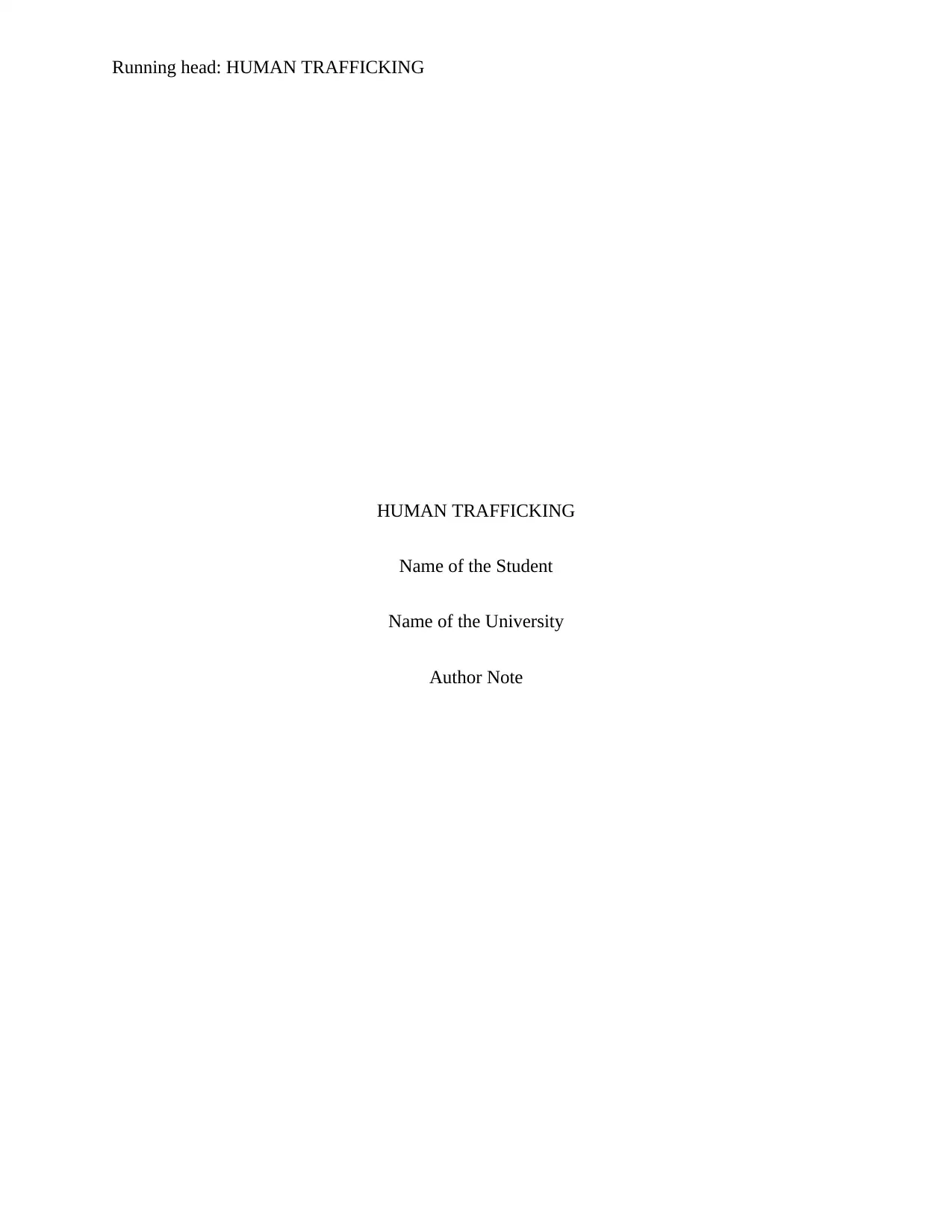
Running head: HUMAN TRAFFICKING
HUMAN TRAFFICKING
Name of the Student
Name of the University
Author Note
HUMAN TRAFFICKING
Name of the Student
Name of the University
Author Note
Secure Best Marks with AI Grader
Need help grading? Try our AI Grader for instant feedback on your assignments.
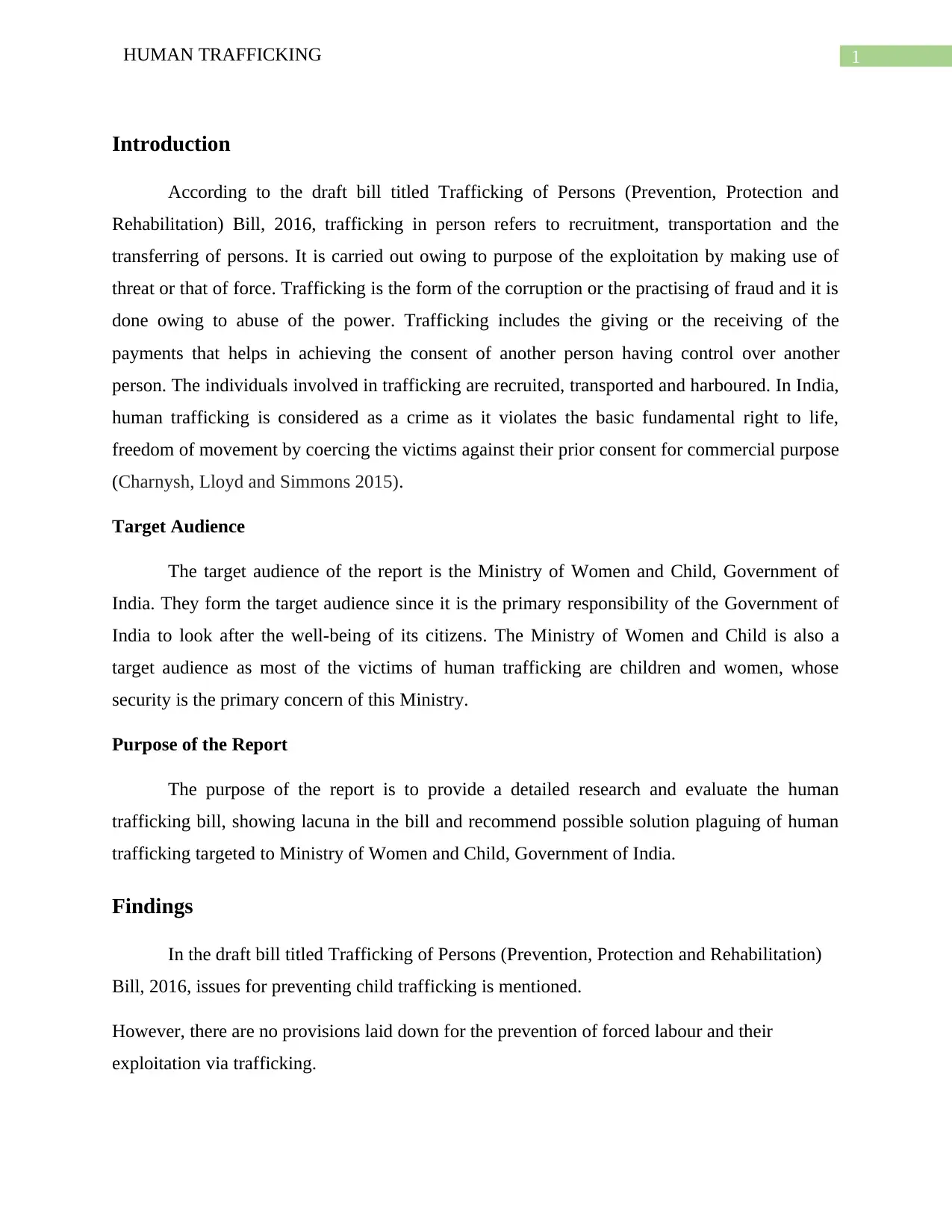
1HUMAN TRAFFICKING
Introduction
According to the draft bill titled Trafficking of Persons (Prevention, Protection and
Rehabilitation) Bill, 2016, trafficking in person refers to recruitment, transportation and the
transferring of persons. It is carried out owing to purpose of the exploitation by making use of
threat or that of force. Trafficking is the form of the corruption or the practising of fraud and it is
done owing to abuse of the power. Trafficking includes the giving or the receiving of the
payments that helps in achieving the consent of another person having control over another
person. The individuals involved in trafficking are recruited, transported and harboured. In India,
human trafficking is considered as a crime as it violates the basic fundamental right to life,
freedom of movement by coercing the victims against their prior consent for commercial purpose
(Charnysh, Lloyd and Simmons 2015).
Target Audience
The target audience of the report is the Ministry of Women and Child, Government of
India. They form the target audience since it is the primary responsibility of the Government of
India to look after the well-being of its citizens. The Ministry of Women and Child is also a
target audience as most of the victims of human trafficking are children and women, whose
security is the primary concern of this Ministry.
Purpose of the Report
The purpose of the report is to provide a detailed research and evaluate the human
trafficking bill, showing lacuna in the bill and recommend possible solution plaguing of human
trafficking targeted to Ministry of Women and Child, Government of India.
Findings
In the draft bill titled Trafficking of Persons (Prevention, Protection and Rehabilitation)
Bill, 2016, issues for preventing child trafficking is mentioned.
However, there are no provisions laid down for the prevention of forced labour and their
exploitation via trafficking.
Introduction
According to the draft bill titled Trafficking of Persons (Prevention, Protection and
Rehabilitation) Bill, 2016, trafficking in person refers to recruitment, transportation and the
transferring of persons. It is carried out owing to purpose of the exploitation by making use of
threat or that of force. Trafficking is the form of the corruption or the practising of fraud and it is
done owing to abuse of the power. Trafficking includes the giving or the receiving of the
payments that helps in achieving the consent of another person having control over another
person. The individuals involved in trafficking are recruited, transported and harboured. In India,
human trafficking is considered as a crime as it violates the basic fundamental right to life,
freedom of movement by coercing the victims against their prior consent for commercial purpose
(Charnysh, Lloyd and Simmons 2015).
Target Audience
The target audience of the report is the Ministry of Women and Child, Government of
India. They form the target audience since it is the primary responsibility of the Government of
India to look after the well-being of its citizens. The Ministry of Women and Child is also a
target audience as most of the victims of human trafficking are children and women, whose
security is the primary concern of this Ministry.
Purpose of the Report
The purpose of the report is to provide a detailed research and evaluate the human
trafficking bill, showing lacuna in the bill and recommend possible solution plaguing of human
trafficking targeted to Ministry of Women and Child, Government of India.
Findings
In the draft bill titled Trafficking of Persons (Prevention, Protection and Rehabilitation)
Bill, 2016, issues for preventing child trafficking is mentioned.
However, there are no provisions laid down for the prevention of forced labour and their
exploitation via trafficking.

2HUMAN TRAFFICKING
Secondly, there are also no provision for the rehabilitation of those who are the victims of
modern form of slavery.
Third, the draft bill is also lacking in the areas of granting human rights to those who are victims
of trafficking.
A fourth shortcoming of the Bill is that it does not provide for any legal support to the victims of
human trafficking, leaving them to fight their own battles.
Finally, the Bill also does not provide any clarity as to whether the victims of human trafficking
shall be prosecuted for any illegal activities done by them as a result of being trafficked.
Recommendations
All these issues needs to be addressed as a victim of human trafficking has already gone
through a lot of mental trauma (Ditmore 2015). If the basic help is not provided to them for
survival, it will be difficult to get their dignity back. One of the ways in which this can be solved
is by giving the victims of human trafficking a rehabilitation centre. This will allow them to have
a place to stay and find themselves again.
Discussion
The human trafficking bill entitled as Trafficking of Persons (Prevention, Protection and
Rehabilitation) Bill, 2016 lays down a ten years stringent punishment of life imprisonment for
serious and ‘aggravated’ forms of trafficking. This includes trading of persons for bonded labour,
administering of chemical hormones which affects the survivor with AIDS, attracting highest
punishment.
Encompassing a wide spectrum of crimes with adequate rescue and rehabilitation
mechanisms through setting up a fund the, the law will be progressive if it is implemented in
letter and spirit (Kempadoo, Sanghera and Pattanaik 2015). Establishment of authorities at
district, state and national level for investigation and rehabilitation, with anti-trafficking units to
investigate and rescue the victims will help in alleviating the plaguing issues more rapidly
(Rahaman 2015).
Secondly, there are also no provision for the rehabilitation of those who are the victims of
modern form of slavery.
Third, the draft bill is also lacking in the areas of granting human rights to those who are victims
of trafficking.
A fourth shortcoming of the Bill is that it does not provide for any legal support to the victims of
human trafficking, leaving them to fight their own battles.
Finally, the Bill also does not provide any clarity as to whether the victims of human trafficking
shall be prosecuted for any illegal activities done by them as a result of being trafficked.
Recommendations
All these issues needs to be addressed as a victim of human trafficking has already gone
through a lot of mental trauma (Ditmore 2015). If the basic help is not provided to them for
survival, it will be difficult to get their dignity back. One of the ways in which this can be solved
is by giving the victims of human trafficking a rehabilitation centre. This will allow them to have
a place to stay and find themselves again.
Discussion
The human trafficking bill entitled as Trafficking of Persons (Prevention, Protection and
Rehabilitation) Bill, 2016 lays down a ten years stringent punishment of life imprisonment for
serious and ‘aggravated’ forms of trafficking. This includes trading of persons for bonded labour,
administering of chemical hormones which affects the survivor with AIDS, attracting highest
punishment.
Encompassing a wide spectrum of crimes with adequate rescue and rehabilitation
mechanisms through setting up a fund the, the law will be progressive if it is implemented in
letter and spirit (Kempadoo, Sanghera and Pattanaik 2015). Establishment of authorities at
district, state and national level for investigation and rehabilitation, with anti-trafficking units to
investigate and rescue the victims will help in alleviating the plaguing issues more rapidly
(Rahaman 2015).
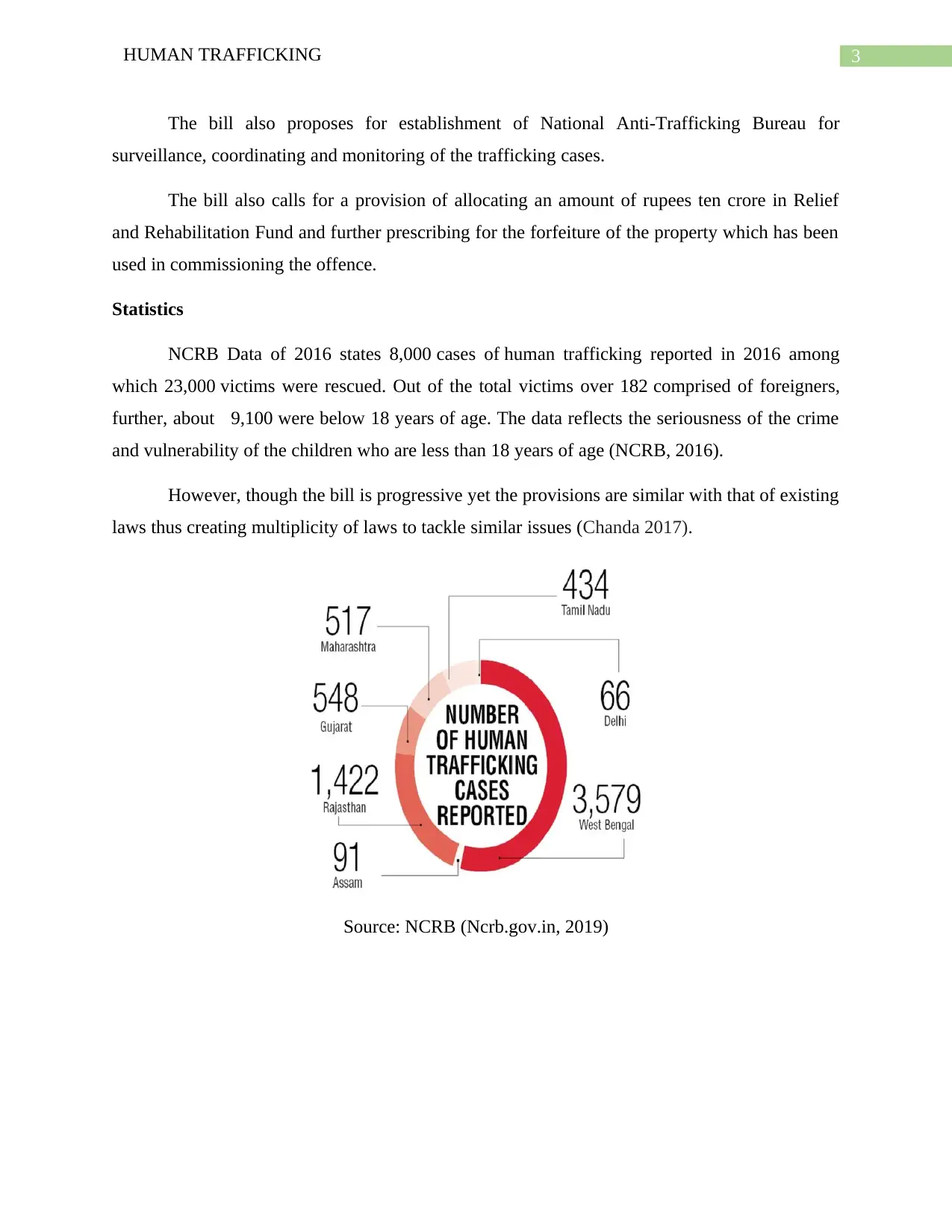
3HUMAN TRAFFICKING
The bill also proposes for establishment of National Anti-Trafficking Bureau for
surveillance, coordinating and monitoring of the trafficking cases.
The bill also calls for a provision of allocating an amount of rupees ten crore in Relief
and Rehabilitation Fund and further prescribing for the forfeiture of the property which has been
used in commissioning the offence.
Statistics
NCRB Data of 2016 states 8,000 cases of human trafficking reported in 2016 among
which 23,000 victims were rescued. Out of the total victims over 182 comprised of foreigners,
further, about 9,100 were below 18 years of age. The data reflects the seriousness of the crime
and vulnerability of the children who are less than 18 years of age (NCRB, 2016).
However, though the bill is progressive yet the provisions are similar with that of existing
laws thus creating multiplicity of laws to tackle similar issues (Chanda 2017).
Source: NCRB (Ncrb.gov.in, 2019)
The bill also proposes for establishment of National Anti-Trafficking Bureau for
surveillance, coordinating and monitoring of the trafficking cases.
The bill also calls for a provision of allocating an amount of rupees ten crore in Relief
and Rehabilitation Fund and further prescribing for the forfeiture of the property which has been
used in commissioning the offence.
Statistics
NCRB Data of 2016 states 8,000 cases of human trafficking reported in 2016 among
which 23,000 victims were rescued. Out of the total victims over 182 comprised of foreigners,
further, about 9,100 were below 18 years of age. The data reflects the seriousness of the crime
and vulnerability of the children who are less than 18 years of age (NCRB, 2016).
However, though the bill is progressive yet the provisions are similar with that of existing
laws thus creating multiplicity of laws to tackle similar issues (Chanda 2017).
Source: NCRB (Ncrb.gov.in, 2019)
Paraphrase This Document
Need a fresh take? Get an instant paraphrase of this document with our AI Paraphraser
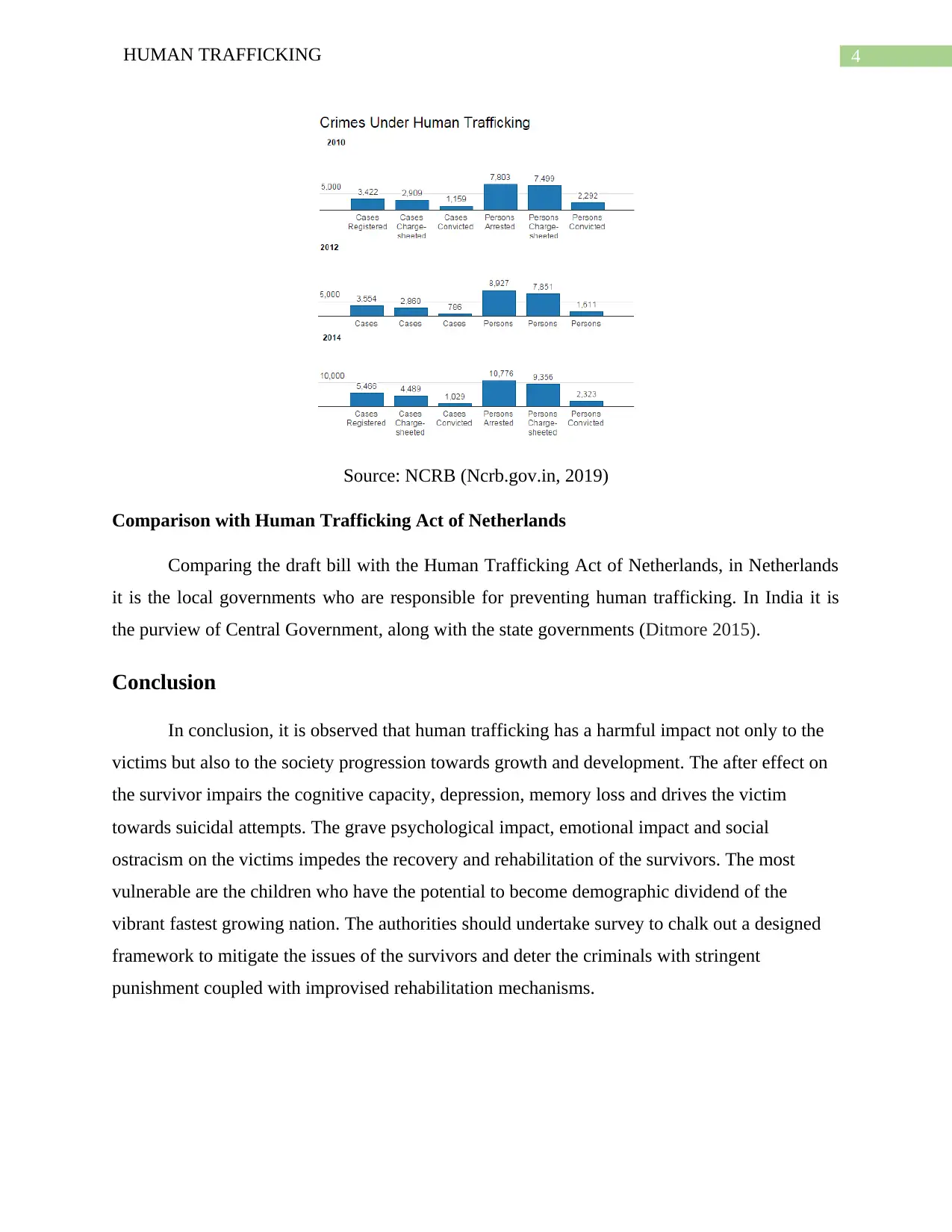
4HUMAN TRAFFICKING
Source: NCRB (Ncrb.gov.in, 2019)
Comparison with Human Trafficking Act of Netherlands
Comparing the draft bill with the Human Trafficking Act of Netherlands, in Netherlands
it is the local governments who are responsible for preventing human trafficking. In India it is
the purview of Central Government, along with the state governments (Ditmore 2015).
Conclusion
In conclusion, it is observed that human trafficking has a harmful impact not only to the
victims but also to the society progression towards growth and development. The after effect on
the survivor impairs the cognitive capacity, depression, memory loss and drives the victim
towards suicidal attempts. The grave psychological impact, emotional impact and social
ostracism on the victims impedes the recovery and rehabilitation of the survivors. The most
vulnerable are the children who have the potential to become demographic dividend of the
vibrant fastest growing nation. The authorities should undertake survey to chalk out a designed
framework to mitigate the issues of the survivors and deter the criminals with stringent
punishment coupled with improvised rehabilitation mechanisms.
Source: NCRB (Ncrb.gov.in, 2019)
Comparison with Human Trafficking Act of Netherlands
Comparing the draft bill with the Human Trafficking Act of Netherlands, in Netherlands
it is the local governments who are responsible for preventing human trafficking. In India it is
the purview of Central Government, along with the state governments (Ditmore 2015).
Conclusion
In conclusion, it is observed that human trafficking has a harmful impact not only to the
victims but also to the society progression towards growth and development. The after effect on
the survivor impairs the cognitive capacity, depression, memory loss and drives the victim
towards suicidal attempts. The grave psychological impact, emotional impact and social
ostracism on the victims impedes the recovery and rehabilitation of the survivors. The most
vulnerable are the children who have the potential to become demographic dividend of the
vibrant fastest growing nation. The authorities should undertake survey to chalk out a designed
framework to mitigate the issues of the survivors and deter the criminals with stringent
punishment coupled with improvised rehabilitation mechanisms.
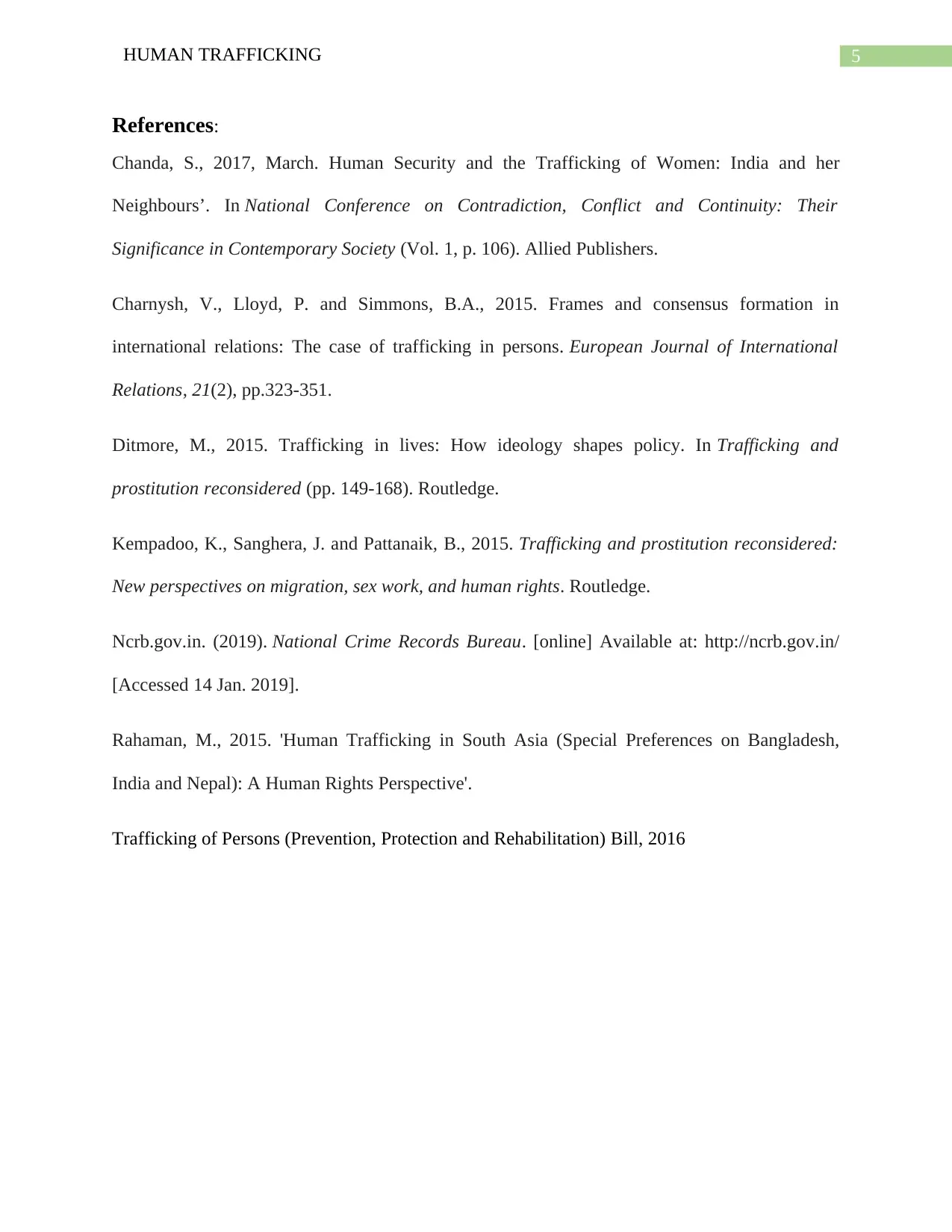
5HUMAN TRAFFICKING
References:
Chanda, S., 2017, March. Human Security and the Trafficking of Women: India and her
Neighbours’. In National Conference on Contradiction, Conflict and Continuity: Their
Significance in Contemporary Society (Vol. 1, p. 106). Allied Publishers.
Charnysh, V., Lloyd, P. and Simmons, B.A., 2015. Frames and consensus formation in
international relations: The case of trafficking in persons. European Journal of International
Relations, 21(2), pp.323-351.
Ditmore, M., 2015. Trafficking in lives: How ideology shapes policy. In Trafficking and
prostitution reconsidered (pp. 149-168). Routledge.
Kempadoo, K., Sanghera, J. and Pattanaik, B., 2015. Trafficking and prostitution reconsidered:
New perspectives on migration, sex work, and human rights. Routledge.
Ncrb.gov.in. (2019). National Crime Records Bureau. [online] Available at: http://ncrb.gov.in/
[Accessed 14 Jan. 2019].
Rahaman, M., 2015. 'Human Trafficking in South Asia (Special Preferences on Bangladesh,
India and Nepal): A Human Rights Perspective'.
Trafficking of Persons (Prevention, Protection and Rehabilitation) Bill, 2016
References:
Chanda, S., 2017, March. Human Security and the Trafficking of Women: India and her
Neighbours’. In National Conference on Contradiction, Conflict and Continuity: Their
Significance in Contemporary Society (Vol. 1, p. 106). Allied Publishers.
Charnysh, V., Lloyd, P. and Simmons, B.A., 2015. Frames and consensus formation in
international relations: The case of trafficking in persons. European Journal of International
Relations, 21(2), pp.323-351.
Ditmore, M., 2015. Trafficking in lives: How ideology shapes policy. In Trafficking and
prostitution reconsidered (pp. 149-168). Routledge.
Kempadoo, K., Sanghera, J. and Pattanaik, B., 2015. Trafficking and prostitution reconsidered:
New perspectives on migration, sex work, and human rights. Routledge.
Ncrb.gov.in. (2019). National Crime Records Bureau. [online] Available at: http://ncrb.gov.in/
[Accessed 14 Jan. 2019].
Rahaman, M., 2015. 'Human Trafficking in South Asia (Special Preferences on Bangladesh,
India and Nepal): A Human Rights Perspective'.
Trafficking of Persons (Prevention, Protection and Rehabilitation) Bill, 2016
1 out of 6
![[object Object]](/_next/static/media/star-bottom.7253800d.svg)



